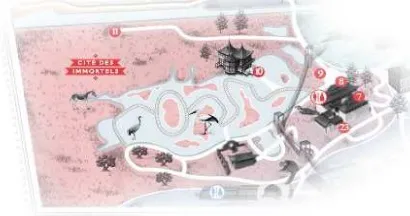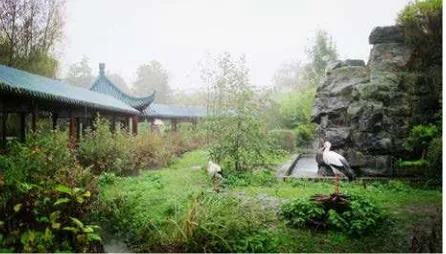Cultural Consumption of the Overseas Chinese Garden in the Process of Cross-cultural
Communication
Zhai Lian a
a
Department of Architecture, SEU,210096, [email protected]
Keywords: Overseas Chinese garden; cross-cultural communication; cultural consumption
ABS TRACT:
When referring to the tangible cultural heritage, people tend to concern more about the conservation and research of the entity of the
tangible heritage than the cross-cultural communication of the cultural heritage which is also one of the most important components of
the preservation of the cultural heritage. As an exotic new born of the cultural heritage, the entity born from the cross-cultural
communication inherits the properties of the cultural heritage on the one hand, and on the other hand generates diversities as a result
of the differences based on social, cultural and environment. And the business model is one of the most important reasons for the
production of diversities. There’s no doubt that a good form of business model makes great significance to the cross-cultural
communication. Therefore, the study of the business model of cultural heritage in the process of cross-cultural communication will
not only contributes to the deeper understanding towards the phenomenon of the cultural heritage’s cross-cultural communication, but
also leads to the introspection to the tangible cultural heritage itself. In this way, a new kind of conservative notion could take form,
and the goal of protecting cultural heritage could be achieved. Thus the Chinese Garden is a typical representation of the cultural
heritage which makes great sense in the cross-cultural communication.
As a kind of tangible cultural heritage, the Chinese gardens are well preserved in different regions in China. While the spirits of the
Chinese garden carry forward through the construction of the Chinese gardens abroad during the cross-cultural communication. As a
new kind of form of the cross-cultural communication of the cultural heritage, on the one hand, the Chinese gardens overseas built
ever since China's Reform and Opening express creatively of the materialist and the spirituality of the traditional Chinese Garden,
and on the other hand, those Chinese gardens overseas face all kinds of tough issued such as investment, business model and
management. The exploration of the reasons for these tough issues makes a great sense of the study towards the cross-cultural
communication and preservation of the cultural heritage.
In this paper, the development of the whole overseas gardens and the cultural consumption of the Chinese gardens in Europe is
generalized, then two typical cases are selected from those two categories mentioned above. By way of field study and interviews, it
shows different strategies towards cultural consumption and provides constructive advice for the survival and development of
overseas Chinese gardens.
1. Introduction——Overview of the Overseas Chinese Gardens From 17th to 18th century, chinoiserie had been popular in
Europe for about 200 years. In the late of 19th century, this
fascination with Chinese art declined as a result of the
corruption of Qing dynasty. It was not until China’s Reform
and Opening up in 1978 that Chinese gardens appeared on the
world stage once again.
In the 1980s, the preoccupation with Chinese gardens once
again took hold with the construction of “M ing Xuan” in the
M etropolitan M useum of Art in New York. With more frequent
exchanges between China and Europe, the Chinese gardens
often sent as presents between sister cities or participated in
international horticultural exhibitions. Now there are more than
50 gardens all over the world, distributed in a total of 17
countries. 20 of them are in Europe, located in Germany,
Chart 1, general information of the Overseas Chinese gardens in Europe built after 1978
(The grey part are the gardens contain consuming behavior. )
General
Usage and Consumption Cultural
Consuming
Non-profit, few tourists. None
2.Si Chuan
From near bankruptcy to
successful operation.
Non-profit,although
subject to geographical
restrictions, the garden
itself is very unique, and
attracts a lot of tourists.
None
has good location, but few
tourists.
Simple cultural
consumption
Non-profit, subject to
geographical restrictions,
has few tourists
None
attached to a larger park,
well-designed, has more
tourists.
Started with commercial
profit, bleak operation,
then bankruptcy. Now it
belongs to the Confucius
Institute.
Simple cultural
consumption
8.Gu su
garden
Switzerland,
2012
Non-public Non-profit, few tourists,
belongs to WTO.
None
the
Non-profit, subject to
geographical restrictions,
Non-profit, large numbers
of tourists
Non-profit, subject to
geographical restrictions,
the garden itself is very
unique, and has a lot of
although subject to
geographical restrictions,
there are a lot of tourists.
integral
Few tourists, garden
teahouse operating bleak.
integral
the garden itself is very
unique, and has a lot of
Non-profit, subject to
geographical restrictions,
subject to geographical
restrictions, few tourists.
Simple cultural
consumption
the a rchitects
(the owner)
2.
Chargeable park
Few tourists, subject to
geographical restrictions
Simplex
cultural
2. The Usage and management Investigation of the Chinese
Gardens in Europe
The background of these gardens’ construction is the advent of
globalization and marketization. Although the reasons for
construction of these gardens differ from one another, they can
be generally divided into two types based on the motivation for
construction: gardens exported from China to Europe, and
gardens generated in Europe under the effect of the
cross-cultural exchange. The former one contains two types:
gardens sent as presents between sister cities in China and
Europe, and gardens built to participate in international flower
expositions. The latter one also contains two types: gardens
invested and built by European companies, and gardens built
by overseas Chinese.
Based on the investigation of the overseas Chinese gardens in
Europe, the management and usage of these gardens is listed in
Chart 1. The grey part shows gardens containing cultural
consuming behavior, the rest are those with free entrance.
From this chart, we can see that the gardens built to participate
in international flower expositions have all free entrance at
present, and gardens constructed out of marketization are
mostly chargeable.
According to whether the consuming objects are the gardens
themselves or not, the cultural consumption can be divided into
two types: the integral one and the simple one. The integral
type means that the Chinese garden is part of a larger one, such
as a Chinese garden in a zoo, or a Chinese garden in a botanical
garden. And the simple type means that the Chinese garden
itself is the whole consuming object.
From Chart 1, it can be concluded that most of the gardens sent
as presents from China to European sister cities belong to the
simple consuming type and there are fewer visitors than
expected. M ost of the gardens originating in Europe are of the
integral consuming type, and they have more visitors and are
usually better designed. In general conclusion, the cultural
consuming types have a close relationship with the gardens’
design method and management, which affect the tourist
numbers as a result.
Therefore, to some extent, the cultural consuming types
determine the survival and development of the overseas
Chinese gardens. And the cultural consuming types have close
relationship with the design and management of the gardens.
The tourists numbers and profit will probably be increased if
the cultural consuming types is combined with the function and
space of the gardens at the start of the project.
In additional, the tourists number doesn’t have an inevitable
relationship with the cultural consumption for many overseas
Chinese gardens are free entrance. Some of them which are
elaborately designed although located in remote areas still have
a great number of tourists, such as the Qian Garden in Bochum,
Germany. The non-profit Chinese gardens face no grim
problem of existence for their funds come from local
governments. Thus the design quality determines the tourists
number; while for the chargeable Chinese gardens, the
consideration for cultural consuming types directly determines
the usage and tourists number in the future.
3. The Integral Cultural Consuming Type——taking example
of Pairi Daiza (Figure 1)
Chart 1 shows that most of the overseas Chinese gardens of the
integral cultural consuming type enjoy high popularity. How
can the integral cultural consuming type attract large number of
tourists? What are the characteristics of the garden design? A
typical case below shows the initial solution to these questions. Figure 1.the site plan of Pairi Daiza
(Image source: http://www.pairidaiza.eu/en)
Figure 2. Site plan of the Chinese garden in Pairi Daiza
The Pairi Daiza, meaning paradise in ancient Persia, is located
60 km away from Brussels, capital of Belgium. The Chinese
garden (Figure 2) in this zoo was built in 2006, covers an area
of 45,000㎡, and is considered the largest Chinese park in
Europe. The design of this park mainly considers two questions:
firstly, how to combine a Chinese garden with local Chinese
animals, secondly, how to combine the Chinese garden with
consuming activities.
The answer to the first question was to build a long zigzag
corridor (Figure 3, 4). The linear space of a corridor brings
tourists with a sense of guidance, and the zigzag shape leads
the tourists’ sight to both sides of the corridor. Thus, the two
sides become a perfect space for animals’ exhibition. The long
zigzag corridor covers almost half of the Chinese garden,
which is rarely seen in traditional Chinese gardens, and the
design of combining corridor with local Chinese animals and
plants is also scarce in modern landscape design.
The answer to the second question, how to combine the
Chinese garden with consuming behavior, is to build some
group buildings associated with courtyards, such as a teahouse
(Figure 5), a footbath room and a Chinese restaurant. These
buildings located at the entrance and existence of the Chinese
garden.
From above we can see, most of the area has nothing to do with
consuming behavior, but how could the zoo profit from these
facilities? While the visitors are wandering in the zoo, they are
immersed in the atmosphere which contains not only the
animals, plants, but also all kinds of experiences. These integral
activities increase the zoo’s attractiveness and as a result
increase the tourists’ number.
4. The Simplex Cultural Consuming Type ——taking example
of Yu Garden in Hamburg (Figure 6)
Chart 1 shows that most of the overseas Chinese gardens in
simple cultural consuming type have little popularity and some
of them are even gradually dying out. How did the simple
cultural consuming type come into being? A typical case below
shows the inherent characteristics of the simple cultural
consuming type.
The Yu Garden in Hamburg, Germany was built up in 2008.
The motivation for construction was to build an arena for
holding Chinese cultural activities. While the investment is
from Yu Garden Company, a private company in shanghai, the
garden had been seeking to make profit since its opening until
2013. In 2010, only 2 years after its completion, the Yu Garden
in Hamburg was closed as a result of non-profitable earnings
and building decay. It was not until 3 years later in 2013, that
the Yu Garden in Hamburg was opened up again. This time it
was managed and funded by the Confucius College in
Hamburg University, and the outcome of the transformation
remains to be seen.
Looking back to the process of this project, the choice of
location had nothing to do with the designers: the government
leader actually chose the site without any market survey. and Figure 3.the long corridor in Pairi Daiza
(Image source: taken by the author )
Figure 4.the animals in Pairi Daiza
(Image source: taken by the author )
Figure 5.the tea house in Pairi Daiza
the garden copied the original Yu Garden in Shanghai without
further design changes. What’s more, the function of the garden
only consists of a tea house and a Chinese restaurant, which has
no connection with its environment. From this case, we can
find that the simplex cultural consuming type is essentially kind
of a static, isolated operation system, which cannot build up
an interactive relationship with consumers, and the social
environment, therefore, it descends to a symbol which
nobody cares about at last.
5. Conclusion
From the comparison of these two cases, the differences
between the two types of cultural consumption can be
concluded as follows (chart 2). In conclusion, overseas Chinese
gardens can be divided into two types according to the
motivation of construction: gardens exported from China to
Europe, and gardens originating in Europe themselves.
According to whether the consuming objects are the gardens
themselves, the cultural consumption type can be divided into
the integral one and the simple one. From the investigation, I
am drawing the conclusion that most of the gardens exported
from China to Europe are of the simple cultural consumption
type, and most of the gardens generated in Europe are of the
integral cultural consumption type.
According to this conclusion, we can give some
recommendations regarding the development of overseas
Chinese gardens: firstly, the design of the gardens should
associate the garden with its social and cultural environment,
combined with the consideration of the atmosphere, people’s
behavior and so on. Secondly, as the gardens exported from
China to Europe are not a direct production of the marketing
operation, they are always filled with the subjective wishes of
the exporters. So the gardens exported from China to Europe
should avoid taking Chinese private companies as investors.
Thirdly, If the investor is a domestic private company, market
investigation and elaborated integral cultural consuming design
is strongly recommended.
Chart 2. Comparison between two kinds of cultural
consumption types
Type of Integral
Cultural
Consumption
Type of S imple
Cultural
Consumption
Motivation
for
Construction
M arket
Requirement
Cross-cultural
communication
Investor Companies
abroad
Domestic companies
S ite The site is
determined by the
investor and
designer,
according to the
action, demand
and the results of
investigation.
The site is determined
by the official leader
instead of the designer,
which results in the
isolation of the garden.
Function Compound
function suit to
the demand
Single function
S pace Space is related to
function, leading
to the experience
out of expectation
Generally copy from
domestic Chinese
gardens
The quality
of
construction
High quality Low quality
Adaptation
to cultural
environment
High Low
Figure 6. Yu Garden in Hamburg
(Image source:
References:
Liu Shaozong 1999. Excellent works of Chinese garden design (Overseas)[M ]. Chinese Architectural Industrial Press.
Gan Weilin. 2000. Cultural envoys 一 the Chinese gardens
overseas [M ] Chinese Architectural Industrial Press.
Liu Xiaoping. 2011. Architectural thinking in the context of
cross-cultural communication [M ] Chinese Architectural
Industrial Press.
Related website:
http://www.pairidaiza.eu/en
http://www.yu-garden.de/
http://finance.sina.com.cn/chanjing/gsnews/20111110/0103107
85811.shtml


